Investigation of a Radial Turbine Design for a Utility-Scale Supercritical CO2 Power Cycle
Abstract
:1. Introduction
- The nature of the high density sCO fluid means that power conversion systems are very compact compared to conventional power cycles [6] (≈ 30 times smaller than steam cycles and ≈ 6 times smaller than air cycles)
- High cycle efficiencies are also obtained, attributed to lower pumping power requirements and the non-ideal gas properties of sCO which translate into lower fuel consumption and lower capital and operating costs. Targeted efficiencies of large-scale, closed supercritical CO Brayton cycles approach 50%
- The suitability of the cycle for waste heat recovery from a variety of heat sources (e.g., nuclear, solar, fossil, geothermal, etc.)
- The application of these high-efficiency cycles reduces greenhouse gas effects because a CO emission is used as a working fluid or as a recycle stream (i.e., not emitted)
- The suitability of sCO cycle systems for use in arid climates because of their ability to use dry cooling (thus saving water) [7]
- Low purification requirements for fluid leakages because the cycle operates above the critical pressure of CO
2. Modelling Methodology
2.1. Cycle Modelling
- One of the benefits of a supercritical CO cycle is small turbomachinery components which implies small blades that require intricate passages if cooling is employed. The design complexities associated with cooling are eliminated by the use of a smaller-scale radial turbine design
- Smaller power output scale so that a radial turbine can still be within acceptable efficiency ranges (power limit shown in Section 3.1.2)
- There is a lack of experience in radial turbine cooling for such high temperatures
2.2. Meanline Design
2.3. Preliminary Design
2.4. Turbine Throughflow Analysis
2.5. Computational Fluid Dynamics
3. Results
3.1. Cycle Modelling
3.1.1. Cooled Cycle Comparison
3.1.2. Modified Cycle
3.2. Preliminary Design
3.3. Computational Fluid Dynamics Analyses
3.3.1. Mesh Sensitivity
3.3.2. Design Point Turbine Analysis
3.3.3. Off-Design Turbine Analysis
3.3.4. Isolated Rotor Analysis
4. Discussion on Enabling Technologies
4.1. Materials Consideration
4.2. Bearings
4.3. Shaft End Seals
4.4. Electrical Configuration
5. Conclusions
- Incorporation of the fluid mixture in the design processes to account for the influence on performance
- Optimisation of the blade profiles
- Additional stress analyses including modal, harmonic, and hot-to-cold simulations
- Experimental testing and validation
- Investigation of the relevant technologies such as seals, bearings, gearing
- Research on suitable material advancements
Author Contributions
Funding
Acknowledgments
Conflicts of Interest
Abbreviations
| Roman Symbols: | |
| b | Passage width [mm] |
| c | Chord [mm] |
| M | Mach number [-] |
| Mass flow rate [kg/s] | |
| N | Number of blades [-] |
| n | Specific speed [-] |
| o | Throat [mm–m] |
| P | Pressure [bar] |
| q | Pitch [mm] |
| Volumetric flow rate [m/s] | |
| R | Degree of reaction [-] |
| r | Radius [mm] |
| s | Entropy [J/kg K] |
| T | Temperature [K– C] |
| t | Thickness [mm] |
| W | Relative velocity [m/s] |
| Power [MW] | |
| Z | Axial length [mm] |
| Greek Symbols: | |
| Absolute flow angle [] | |
| Relative flow angle [] | |
| Difference [-] | |
| Efficiency [%] | |
| Velocity ratio [-] | |
| Rotational speed [rad/s] | |
| Flow coefficient [-] | |
| Pressure ratio [-] | |
| Stage loading coefficient [-] | |
| Density [kg/m] | |
| Metal angle [] | |
| Subscripts: | |
| 0 | Total value |
| 2 | Stator inlet station |
| 3 | Stator outlet station |
| 4 | Rotor inlet station |
| 5 | Rotor outlet station |
| e | Electric |
| id | Ideal |
| m | Meanline |
| max | Maximum |
| out | Outlet |
| R | Rotor |
| rel | Relative reference frame |
| S | Stator |
| th | Thermal |
| ts | Total-to-static |
| tt | Total-to-total |
| Acronyms/Abbreviations: | |
| ASU | Air Separation Unit |
| CCS | Carbon Capture and Storage |
| CFD | Computational Fluid Dynamics |
| GE | General Electric |
| HTHE | High Temperature Heat Exchanger |
| IEA GHG | International Energy Agency GreenHouse Gas |
| LHV | Lower Heating Value |
| LTHE | Low Temperature Heat Exchanger |
| PS | Pressure Side |
| SS | Suction Side |
| TIP | Turbine Inlet Pressure |
| TIT | Turbine Inlet Temperature |
References
- Ahn, Y.; Lee, J.I. Study of Various Brayton Cycle Designs for Small Modular Sodium-Cooled Fast Reactor. Nucl. Eng. Des. 2014, 276, 128–141. [Google Scholar] [CrossRef]
- Dahlquist, A.; Genrup, M. Aerodynamic Turbine Design for an Oxy-Fuel Combined Cycle. In Proceedings of the ASME Turbo Expo 2016: Turbomachinery Technical Conference and Exposition (GT 2016), Seoul, Korea, 13–17 June 2016; Volume 2. [Google Scholar]
- Dahlquist, A.; Genrup, M.; Sjoedin, M.; Jonshagen, K. Optimization of an Oxyfuel Combined Cycle Regarding Performance and Complexity Level. In Proceedings of the ASME Turbo Expo 2013: Turbine Technical Conference and Exposition, San Antonio, TX, USA, 3–7 June 2013. [Google Scholar]
- Zhang, N.; Lior, N. Two Novel Oxy-Fuel Power Cycles Integrated with Natural Gas Reforming and CO2 Capture. Energy 2008, 33, 340–351. [Google Scholar] [CrossRef]
- Olumayegun, O.; Wang, M.; Kelsall, G. Closed-Cycle Gas Turbine for Power Generation: A State-of-the-Art Review. Fuel 2016, 180, 694–717. [Google Scholar] [CrossRef]
- Kato, Y.; Nitawaki, T.; Muto, Y. Medium Temperature Carbon Dioxide Gas Turbine Reactor. Nucl. Eng. Des. 2004, 230, 195–207. [Google Scholar] [CrossRef]
- Turchi, C.; Ma, Z.; Neises, T.W.; Wagner, M.J. Thermodynamic Study of Advanced Supercritical Carbon Dioxide Power Cycles for Concentrating Solar Power Systems. J. Sol. Energy Eng. 2013, 135, 041007. [Google Scholar] [CrossRef]
- Allam, R.; Palmer, M.; Brown, G.; Fetvedt, J.; Freed, D.; Nomoto, H.; Itoh, M.; Okita, N.; Jones, C. High Efficiency and Low Cost of Electricity Generation from Fossil Fuels while Eliminating Atmospheric Emissions, Including Carbon Dioxide. Energy Procedia 2013, 37, 1135–1149. [Google Scholar] [CrossRef] [Green Version]
- IEAGHG. Oxy-Combustion Turbine Power Plants; IEAGHG: Cheltenham, UK, 2015. [Google Scholar]
- Scaccabarozzi, R.; Gatti, M.; Martelli, E. Thermodynamic Analysis and Numerical Optimization of the NET Power Oxy-Combustion Cycle. Appl. Energy 2016, 178, 505–526. [Google Scholar] [CrossRef]
- Allam, R.; Fetvedt, J.; Forrest, B.; Freed, D. The Oxy-Fuel, Supercritical CO2 Allam Cycle: New Cycle Developments to Produce Even Lower-Cost Electricity From Fossil Fuels Without Atmospheric Emissions. In Proceedings of the ASME Turbo Expo 2014: Turbine Technical Conference and Exposition. American Society of Mechanical Engineers, Düsseldorf, Germany, 16–20 June 2014. [Google Scholar]
- Allam, R.; Martin, S.; Forrest, B.; Fetvedt, J.; Lu, X.; Freed, D.; Brown, G.; Sasaki, T.; Itoh, M.; Manning, J. Demonstration of the Allam Cycle: An Update on the Development Status of a High Efficiency Supercritical Carbon Dioxide Power Process Employing Full Carbon Capture. Energy Procedia 2017, 114, 5948–5966. [Google Scholar] [CrossRef]
- Aspen Technology Inc. Aspen Plus User Guide 10.2; Aspen Technology Inc.: Bedford, MA, USA, 2000. [Google Scholar]
- White, M.; Sayma, A. A Preliminary Comparison of Different Turbine Architectures for a 100kW Supercritical CO2 Rankine Sycle Turbine. In Proceedings of the 6th International Supercritical CO2 Power Cycles Symposium, Pittsburgh, PA, USA, 27–29 March 2018. [Google Scholar]
- Holaind, N.; Bianchi, G.; De Miol, M.; Saravi, S.; Tassou, S.; Leroux, A.; Jouhara, H. Design of Radial Turbomachinery for Supercritical CO2 Systems using Theoretical and Numerical CFD Methodologies. Energy Procedia 2017, 123, 313–320. [Google Scholar] [CrossRef]
- Zhang, H.; Zhao, H.; Deng, Q.; Feng, Z. Aerothermodynamic Design and Numerical Investigation of Supercritical Carbon Dioxide Turbine. In Proceedings of the ASME Turbo Expo 2015: Turbine Technical Conference and Exposition, Montreal, QC, Canada, 15–19 June 2015. [Google Scholar]
- Wang, Y.; Li, J.; Zhang, D.; Xie, Y. Numerical Investigation on Aerodynamic Performance of SCO2 and Air Radial-Inflow Turbines with Different Solidity Structures. Appl. Sci. 2020, 10, 2087. [Google Scholar] [CrossRef] [Green Version]
- Aungier, R. Turbine Aerodynamics Axial-Flow and Radial-Inflow Turbine Design and Analysis; ASME, Three Park Avenue: New York, NY, USA, 2006. [Google Scholar]
- Rahbar, K.; Mahmoud, S.; Al-Dadah, R. Mean-Line Modeling and CFD Analysis of a Miniature Radial Turbine for Distributed Power Generation Systems. Int. J. Low Carbon Technol. 2016, 11, 157–168. [Google Scholar] [CrossRef] [Green Version]
- Moroz, L.; Govorushchenko, Y.; Pagur, P.; Grebennik, K.; Kutrieb, W.; Kutrieb, M. Integrated Environment for Gas Turbine Preliminary Design. In Osaka International Gas Turbine Congress; Citeseer: Osaka, Japan, 2011; pp. 13–18. [Google Scholar]
- Shah, S.; Chaudhri, G.; Kulshreshtha, D.; Channiwalla, S. Radial Inflow Gas Turbine Flow Path Design. Int. J. Eng. Res. Dev. 2013, 5, 41–45. [Google Scholar]
- Aungier, R. A Fast, Accurate Real Gas Equation of State for Fluid Dynamic Analysis Applications. J. Fluids Eng. 1995, 117, 277–281. [Google Scholar] [CrossRef]
- Meijboom, L. Development of a Turbine Concept for Supercritical CO2 Power Cycles. Master’s Thesis, Delft University of Technology, Delft, The Netherlands, 2017. [Google Scholar]
- Dong, B.; Xu, G.; Luo, X.; Zhuang, L.; Quan, Y. Analysis of the Supercritical Organic Rankine Cycle and the Radial Turbine Design for High Temperature Applications. Appl. Therm. Eng. 2017, 123, 1523–1530. [Google Scholar] [CrossRef]
- Pecnik, R.; Rinaldi, E.; Colonna, P. Computational Fluid Dynamics of a Radial Compressor Operating with Supercritical CO2. J. Eng. Gas Turbines Power 2012, 134, 122301. [Google Scholar] [CrossRef]
- Wei, Z. Meanline Analysis of Radial Inflow Turbines at Design and Off-Design Conditions. Master’s Thesis, Carleton University, Ottawa, ON, Canada, 2014. [Google Scholar]
- Takagi, K.; Muto, Y.; Ishizuka, T.; Kikura, H.; Aritomi, M. Research on Flow Characteristics of Supercritical CO2 Axial Compressor Blades by CFD Analysis. In Proceedings of the 17th International Conference on Nuclear Engineering ICONE17, Brussels, Belgium, 12–16 July 2009; Volume 4, pp. 565–572. [Google Scholar]
- Horlock, J.; Torbidoni, L. Calculations of cooled turbine efficiency. J. Eng. Gas Turbines Power 2008, 130, 011703. [Google Scholar] [CrossRef]
- Wilcock, R.; Young, J.; Horlock, J. The Effect of Turbine Blade Cooling on the Cycle Efficiency of Gas Turbine Power Cycles. J. Eng. Gas Turbines Power 2005, 127, 109–120. [Google Scholar] [CrossRef]
- Fleming, D.; Holschuh, T.; Conboy, T.; Rochau, G.; Fuller, R. Scaling Considerations for a Multi-Megawatt Class Supercritical CO2 Brayton Cycle and Path Forward for Commercialization. In Proceedings of the ASME Turbo Expo 2012: Turbine Technical Conference and Exposition, Copenhagen, Denmark, 11–15 June 2012; pp. 953–960. [Google Scholar]
- Dixon, S.; Hall, C. Fluid Mechanics and Thermodynamics of Turbomachinery; Butterworth-Heinemann: Oxford, UK, 2010. [Google Scholar]
- Watch, M. Gas Turbine Market Size 2018- Global Analysis, Comprehensive Research Study, Development Status, Business Growth, Competitive Landscape, Future Plans and Trends by Forecast 2023. 2019. Available online: https://www.marketwatch.com/press-release/ (accessed on 18 December 2019).
- Cerdoun, M.; Ghenaiet, A. CFD Analyses of a Radial Inflow Turbine. In Proceedings of the 8th International Conference on Compressors and Their Systems, London, UK, 9–10 September 2013; Woodhead Publishing: Sawston, UK, 2013; pp. 635–647. [Google Scholar]
- Monteiro, V.; Zaparoli, E.; de Andrade, C.; de Lima, R. Numerical Simulation of Performance of an Axial Turbine First Stage. J. Aerosp. Technol. Manag. 2012, 4, 175–184. [Google Scholar] [CrossRef]
- Sauret, E.; Gu, Y. 3D CFD Simulations of a Candidate R143a Radial-Inflow Turbine for Geothermal Power Applications. In Proceedings of the ASME 2014 Power Conference: Turbine Technical Conference and Exposition, Düsseldorf, Germany, 16–20 June 2014. [Google Scholar]
- Baines, N. Introduction to Radial Turbine Technology; VKI Radial Turbines: Sint-Genesius-Rode, Belgium, 1992. [Google Scholar]
- Metals, H.T. Inconel 718 Technical Data. 2015. Available online: https://www.hightempmetals.com/techdata/hitempInconel718data.php (accessed on 18 December 2019).
- Brun, K.; Friedman, P.; Dennis, R. Fundamentals and Applications of Supercritical Carbon Dioxide (sCO2) Based Power Cycles; Woodhead Publishing: Sawston, UK, 2017. [Google Scholar]
- Barua, S. High-Temperature Hot Corrosion of Gas Turbine Materials. Master’s Thesis, Cranfield University, Cranfield, UK, 2018. [Google Scholar]
- Wright, I.; Pint, B.; Shingledecker, J.; Thimsen, D. Materials Considerations for Supercritical CO2 Turbine Cycles. In Proceedings of the ASME Turbo Expo 2013: Turbine Technical Conference and Exposition, San Antonio, TX, USA, 3–7 June 2013. [Google Scholar]
- Subbaraman, G.; Kung, S.; Saari, H. Materials for Supercritical CO2 Applications. In Proceedings of the 6th International Supercritical CO2 Power Cycles Symposium, Pittsburgh, PA, USA, 27–29 March 2018. [Google Scholar]
- Essilfie-Conduah, N. Operating Conditions and Materials Selection for Gas-Fired Supercritical CO2. Master’s Thesis, Cranfield University, Cranfield, UK, 2019. [Google Scholar]
- Finn, J.; He, X.; Apte, S. Erosion in Components of Supercritical CO2 Power Cycles. In Utsr Project Review Meeting; National Energy Technology Laboratory: Pittsburgh, PA, USA, 2018. [Google Scholar]
- Cho, J.; Choi, M.; Baik, Y.; Lee, G.; Ra, H.; Kim, B.; Kim, M. Development of the Turbomachinery for the Supercritical Carbon Dioxide Power Cycle. Int. J. Energy Res. 2016, 40, 587–599. [Google Scholar] [CrossRef]
- McClung, A.; Smith, N.; Allison, T.; Tom, B. Practical Considerations for the Conceptual Design of an sCO2 Cycle. In Proceedings of the 6th International Supercritical CO2 Power Cycles Symposium, Pittsburgh, PA, USA, 27–29 March 2018. [Google Scholar]
- Allison, T.; Wilkes, J.; Brun, K.; Moore, J. Turbomachinery Overview for Supercritical CO2 Power Cycles. In Proceedings of the 46th Turbomachinery and 33rd Pump Symposia, Houston, TX, USA, 12–14 December 2017; Southwest Research Institute: San Antonio, TX, USA, 2017. [Google Scholar]
- Fleming, D. Private Communication-Telephone; Sandia National Laboratories: Albuquerque, NM, USA, 2019. [Google Scholar]
- Chapman, P. Advanced Gas Foil Bearing Design for Supercritical CO2 Power Cycles. In Proceedings of the 5th International Supercritical CO2 Power Cycles Symposium, San Antonio, TX, USA, 28–31 March 2016. [Google Scholar]
- Liu, J.; Dent, P.; Palazzolo, A. Novel Ultra High Temperature Magnetic Bearings for Space Vehicle Systems; Technical Report; Electron Energy Corporation: Landisville, PA, USA, 2018. [Google Scholar]
- Bidkar, R.; Sevincer, E.; Wang, J.; Thatte, A.; Mann, A.; Peter, M.; Musgrove, G.; Allison, T.; Moore, J. Low-Leakage Shaft-End Seals for Utility-Scale Supercritical CO2 Turboexpanders. J. Eng. Gas Turbines Power 2016, 139, 022503. [Google Scholar] [CrossRef] [Green Version]
- Fleming, D. Experience with < 1MW Supercritical Power Generation Technology Development; Technical Report; Sandia National Laboratories: Albuquerque, NM, USA, 2017. [Google Scholar]
- Bidkar, R.; Mann, A.; Singh, R.; Sevincer, E.; Cich, S.; Day, M.; Kulhanek, C.; Thatte, A.; Peter, A.; Hofer, D.; et al. Conceptual Designs of 50 MWe and 450 MWe Supercritical CO2 Turbomachinery Trains for Power Generation from Coal. Part 1: Cycle and Turbine. In Proceedings of the 5th International Symposium—Supercritical CO2 Power Cycles, San Antonio, TX, USA, 28–31 March 2016. [Google Scholar]
- Systems, G.P. Steam Turbines for Industrial Applications. Available online: https://www.ge.com/content/dam/gepower-pgdp/global/en_US/documents/technical/ger/ger-3706d-steam-turbines-industrial-applications.pdf (accessed on 1 March 2020).
- Systems, M.H.P. Geared Turbines. Available online: https://www.mhps.com/products/steamturbines/lineup/industrial/deceleration/ (accessed on 18 March 2020).

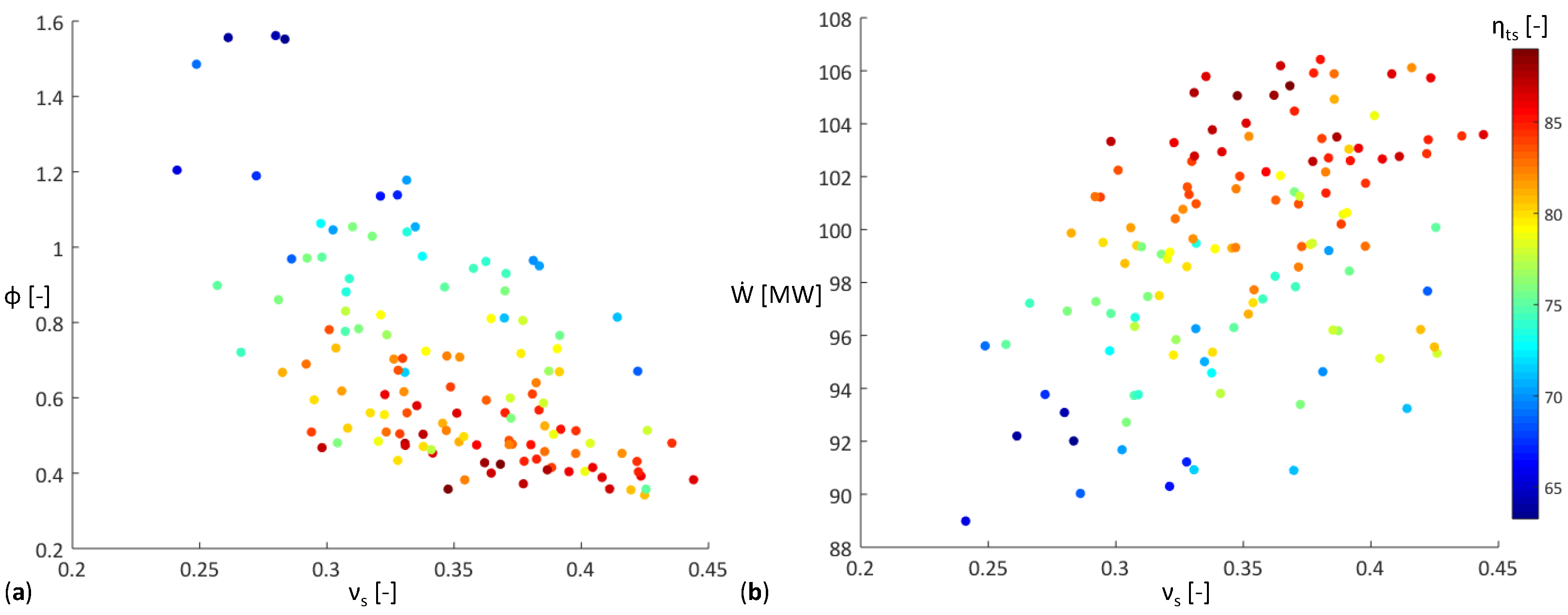
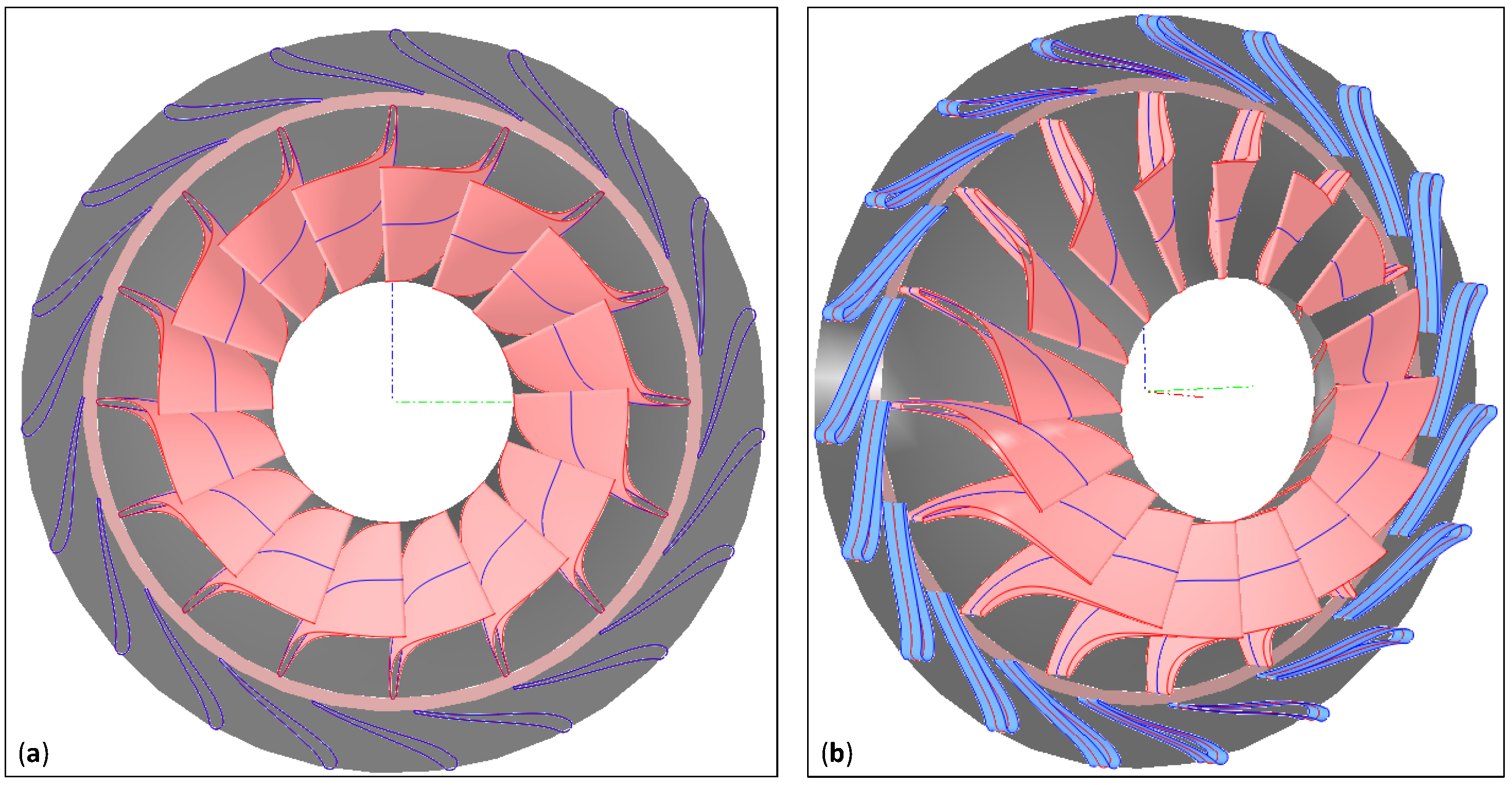
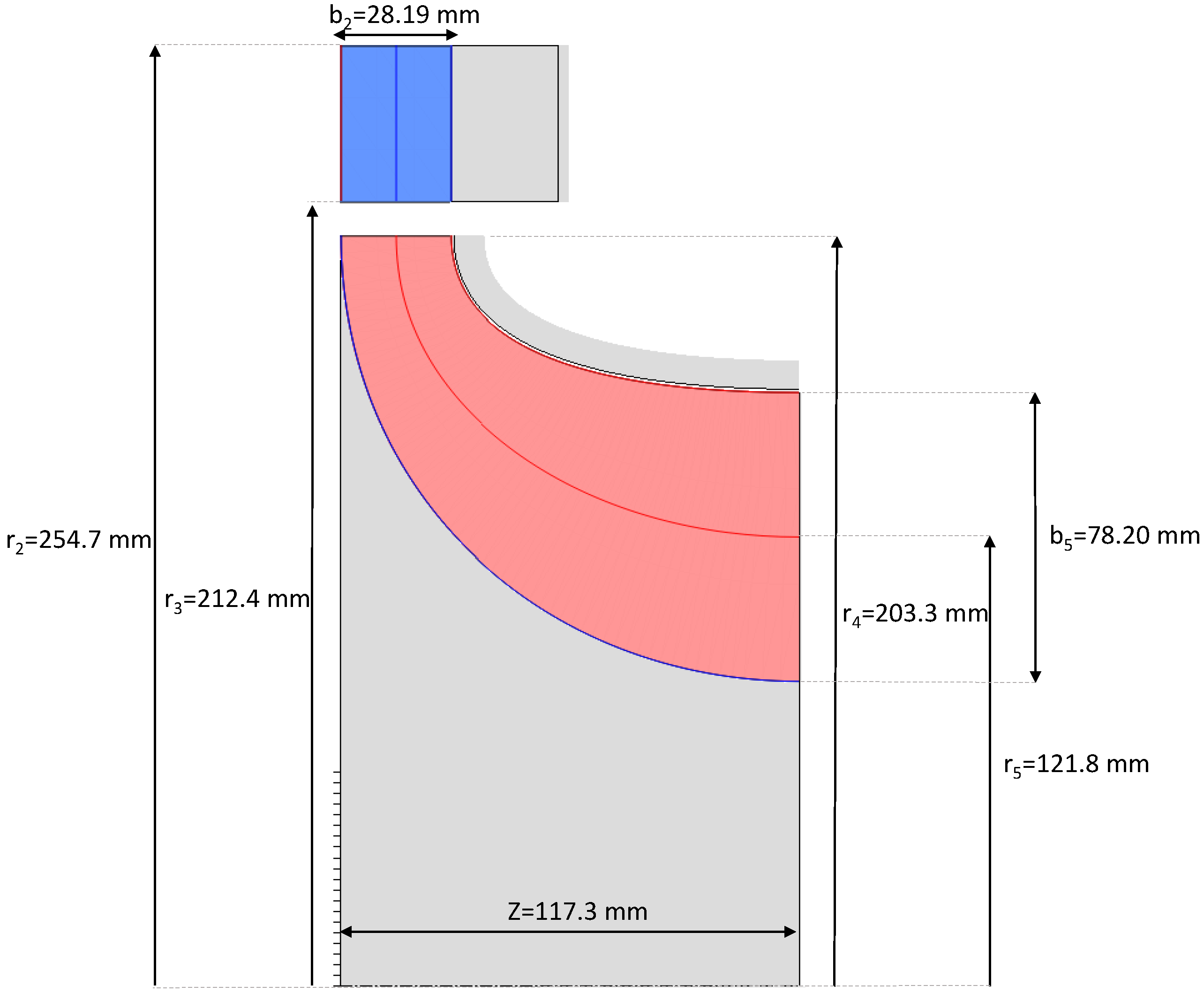
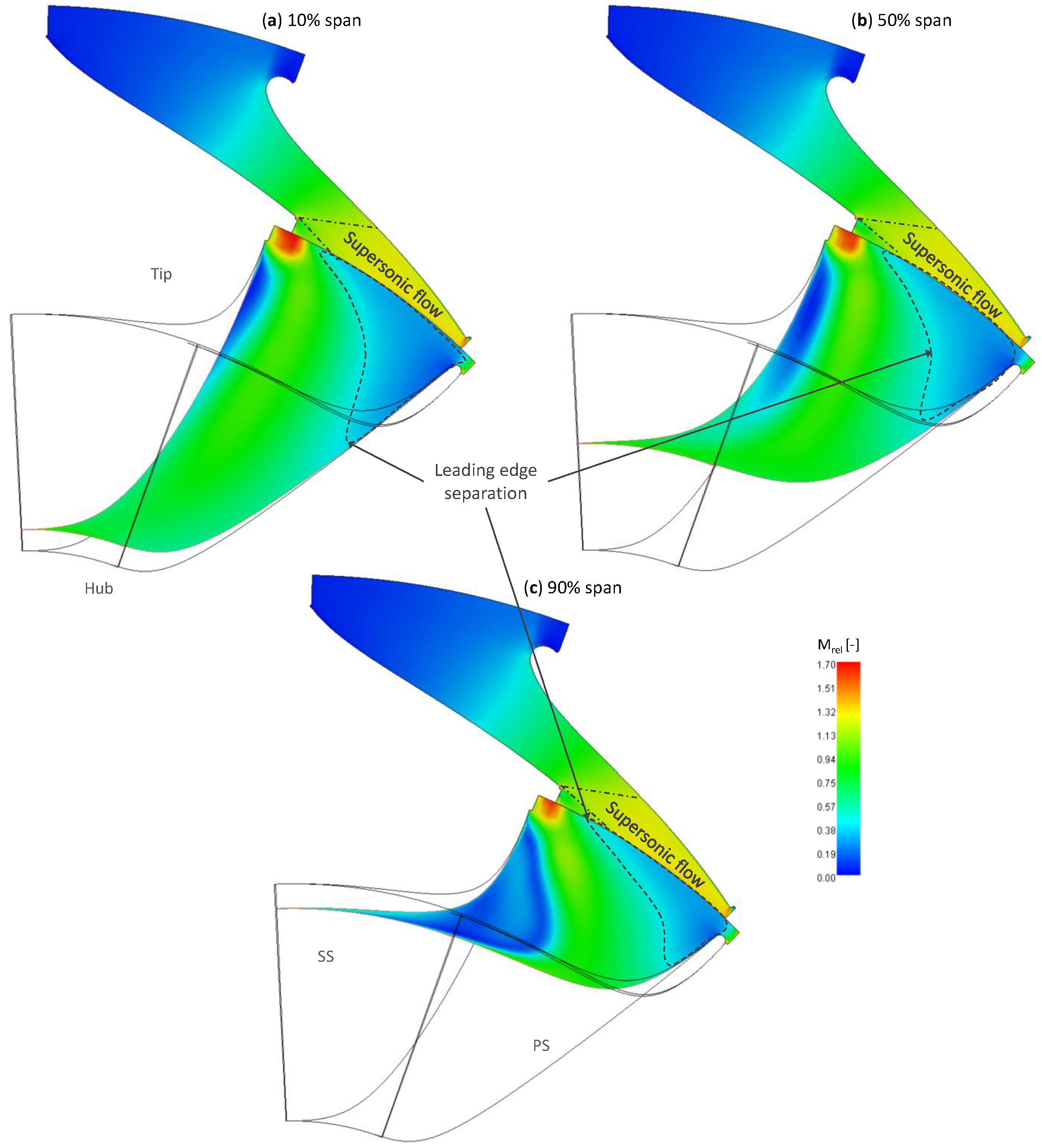
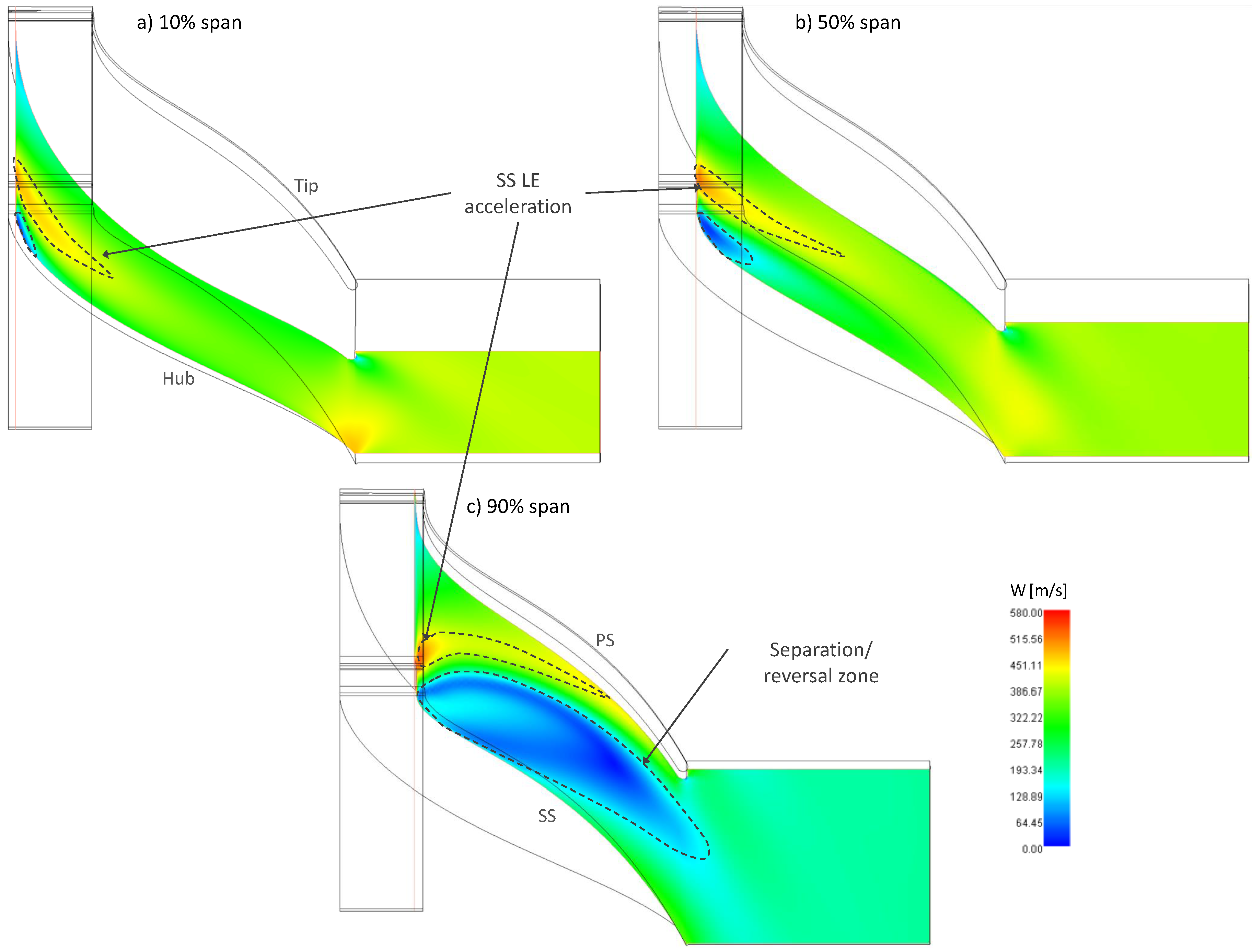

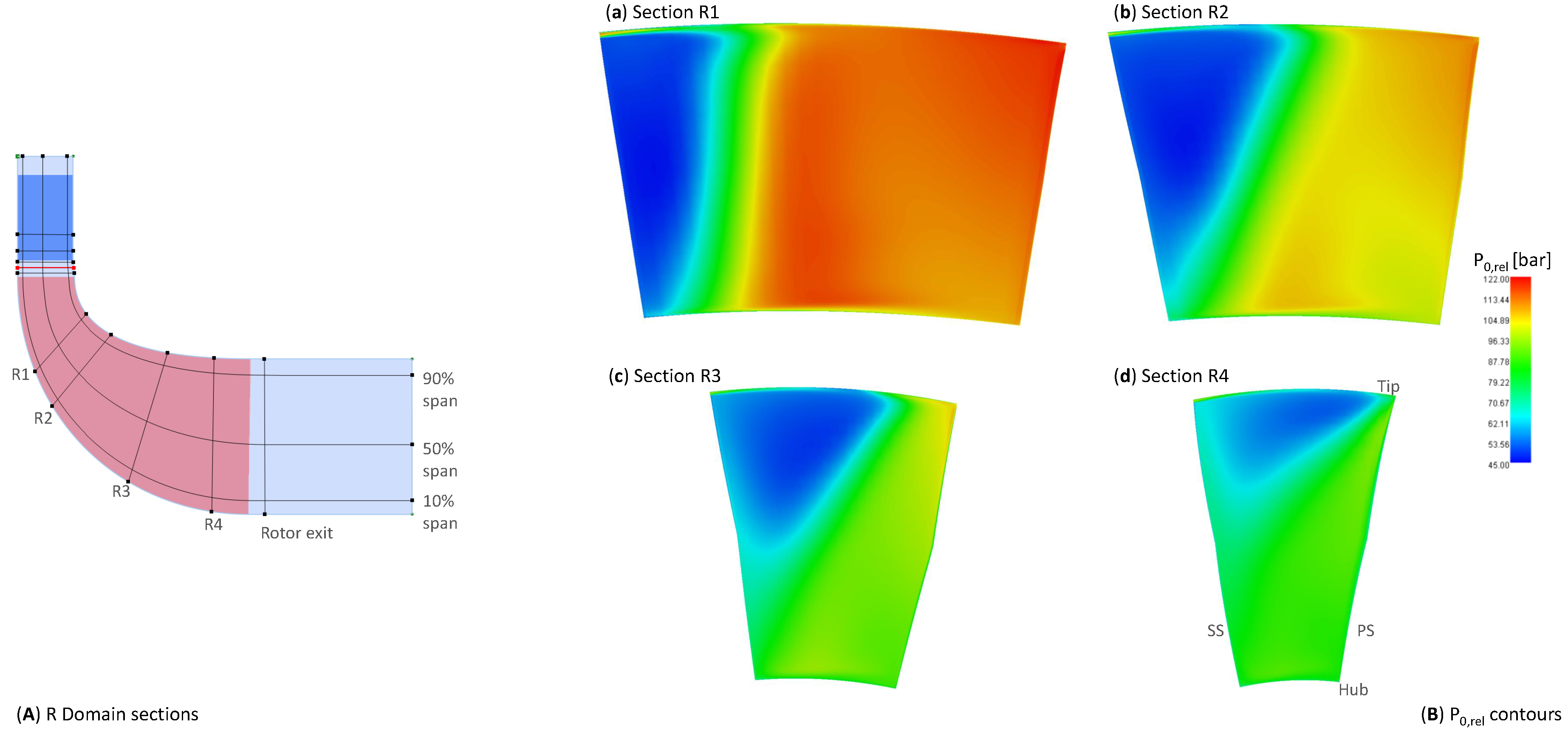
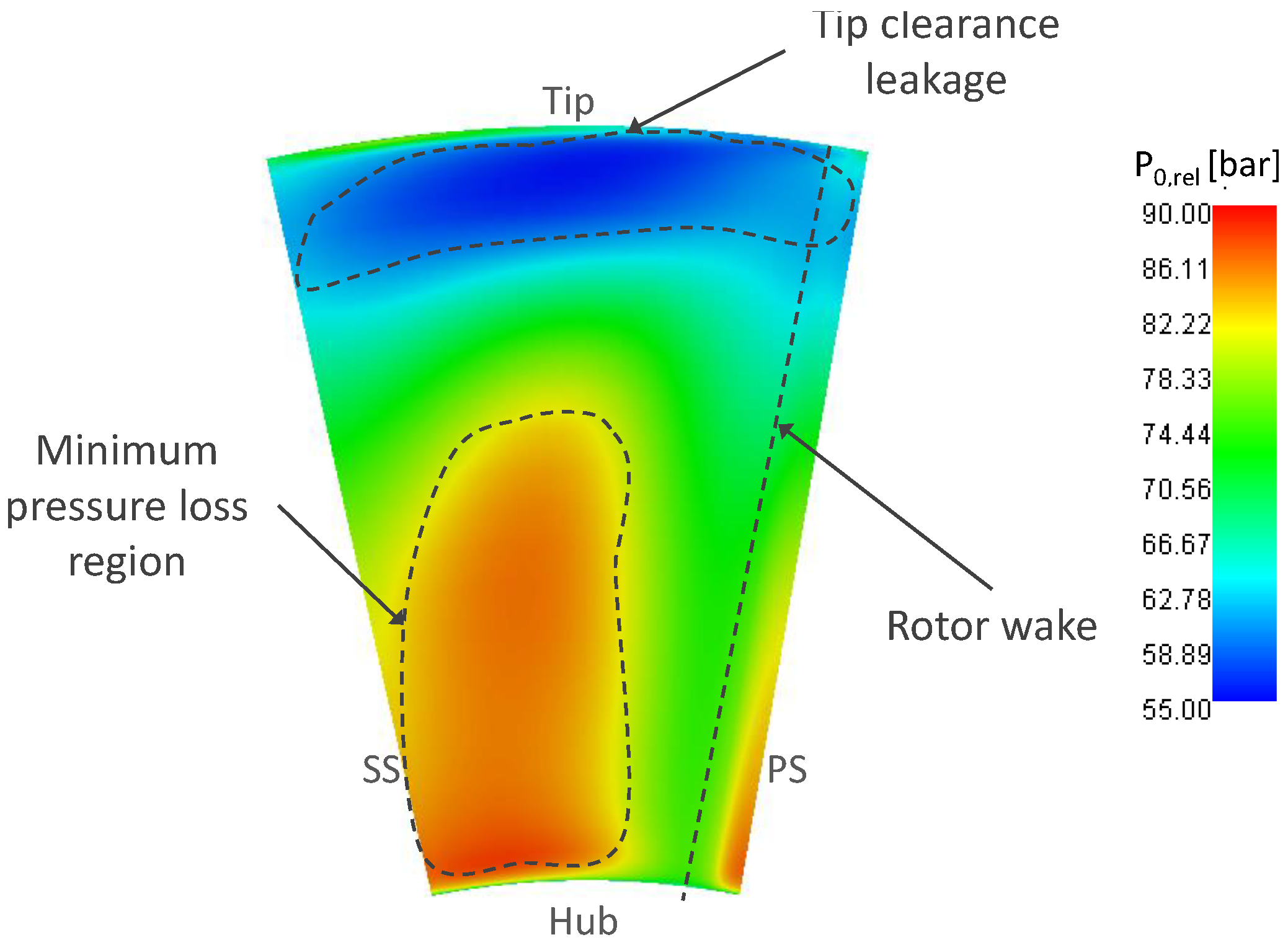




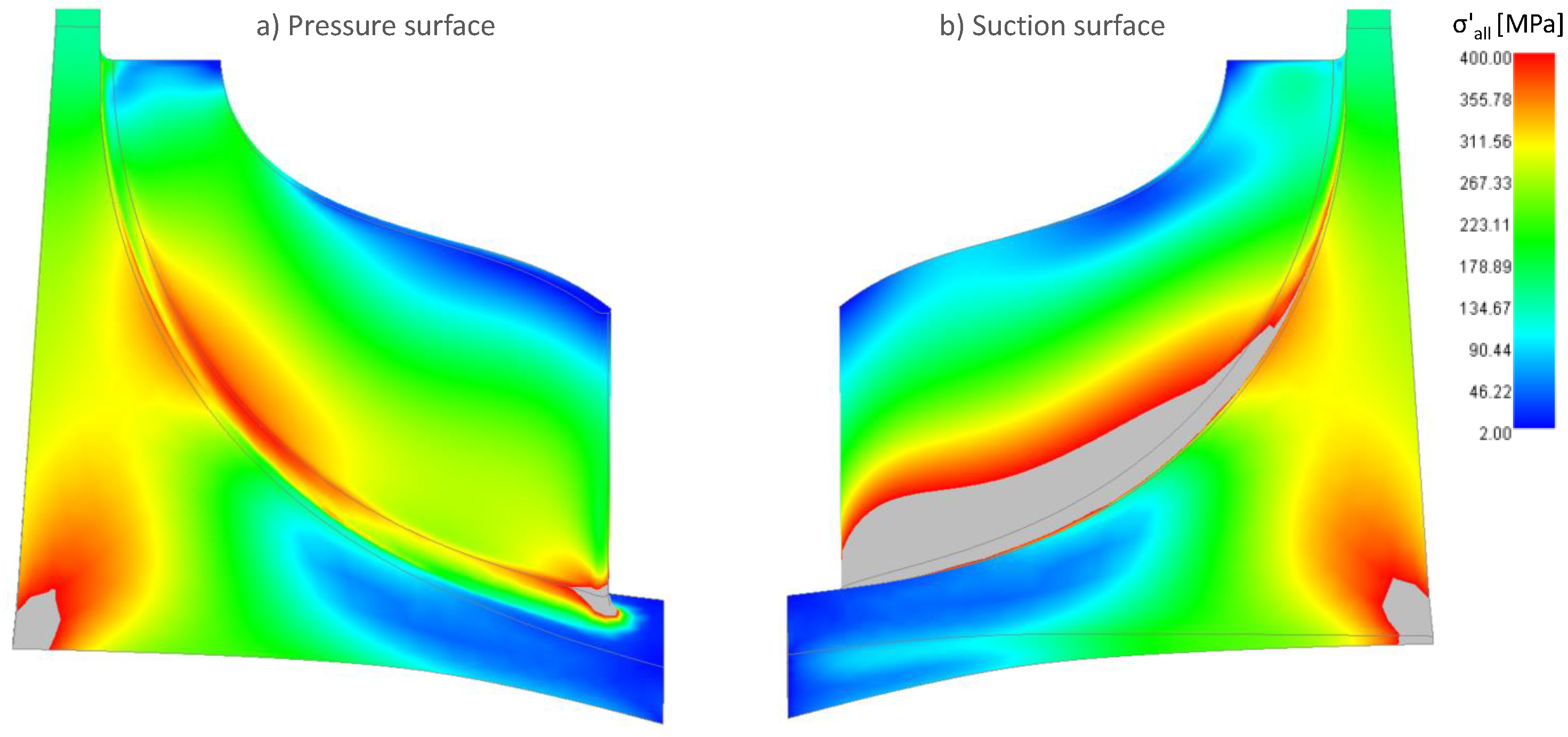
| Parameter | Unit | Constraint |
|---|---|---|
| Power | MW | ≥ from cycle Section 3.1 |
| Efficiency | % | ≥80 |
| Flow coefficient | - | <1 |
| Rotor inlet blade speed | m/s | ≈450 |
| Rotor outlet absolute flow angle | ≈0 |
| Unit | Results of This Work | Results of [10] Optimised Cycle | |
|---|---|---|---|
| Thermal energy of feedstock (LHV) | MW | 768.21 | 768.31 |
| Turbine power output | MW | 610.55 | 609.74 |
| Recycle flow compressors | MW | 88.00 | 97.81 |
| Natural gas compressor | MW | 3.97 | - |
| Air separation unit | MW | 85.51 | - |
| Storage compressor | MW | 0.25 | - |
| Net electric power output | MW | 432.82 | 421.06 |
| Turbine outlet temperature | C | 830.53 | 783.81 |
| Turbine inlet flow rate | kg/s | 1567.7 | 1513.7 |
| Net electric efficiency (LHV) | % | 56.34 | 54.80 |
| Data | Unit | Value |
|---|---|---|
| HTHE heat duty | MW | 242.92 |
| LTHE heat duty | MW | 43.42 |
| Thermal energy of feedstock (LHV) | MW | 137.18 |
| Turbine power output | MW | 99.31 |
| Vapor phase compressors | MW | 3.96 |
| Dense phase compressors | MW | 8.86 |
| Oxidant compressor | MW | 3.09 |
| Total flow compressors | MW | 15.91 |
| Natural gas compressor | MW | 0.74 |
| Air separation unit | MW | 15.29 |
| Storage compressor | MW | 0.045 |
| Net electric power output | MW | 67.33 |
| Net electric efficiency (LHV) | % | 49.08 |
| Data | Unit | Value |
|---|---|---|
| Inlet temperature (T) | C | 900 |
| Inlet pressure (P) | bar | 297 |
| Mass flow rate | kg/s | 354.2 |
| Outlet pressure | bar | 60 |
| Thermal power output () | MW | 100.7 |
| Fluid Component Mole Fractions | ||
| CO | % | 94.06 |
| HO | % | 4.13 |
| N | % | 1.14 |
| Ar | % | 0.55 |
| O | % | 0.12 |
| Variable | Unit | Value |
|---|---|---|
| Boundary Conditions | ||
| Inlet total pressure | bar | 297 |
| Inlet total temperature | K | 1173 |
| Outlet total pressure | bar | 60 |
| Mass flow rate | kg/s | 354.2 |
| Inlet rotor metal angle | 90 | |
| Shaft rotational speed | rpm | 17,000–24,000 |
| Geometric Parameters and Constraints | ||
| Stator outlet mean diameter | m | 0.4–0.6 |
| Rotor blade height ratio | - | 2–3 |
| Rotor diameter ratio | - | 1.5–3 |
| Rotor inlet height | m | 0.01–0.04 |
| Hub reaction | - | 0.3–0.5 |
| Stator inlet diameter | m | 0.4–0.8 |
| Inlet flow angle | 1–179 | |
| Rotor outlet hub diameter | m | 0.05–0.3 |
| Stator | Rotor | ||||
|---|---|---|---|---|---|
| Variable | Unit | Value | Data | Unit | Value |
| Blade count (N) | - | 19 | N | - | 16 |
| Chord (c) | mm | 99.90 | c | mm | 176.0 |
| Pitch (q) | mm | 70.24 | q | mm | 47.81 |
| Inlet thickness (t) | mm | 9.150 | t | mm | 3.520 |
| Outlet thickness (t) | mm | 1.830 | t | mm | 3.520 |
| Throat (o) | mm | 16.82 | o | mm | 28.35 |
| Inlet angle () | 112.42 | 90 | |||
| Outlet angle () | 13.86 | 36.37 | |||
| Variable | Unit | Value |
|---|---|---|
| kg/s | 354.6 | |
| MW | 101.6 | |
| Total-to-total efficiency () | % | 88.25 |
| Total-to-static efficiency () | % | 83.40 |
| - | 0.344 | |
| Stage loading () | - | 1.42 |
| - | 0.433 | |
| Degree of reaction (R) | - | 0.282 |
| - | 5.52 |
| Boundary Condition: & P | ||||
|---|---|---|---|---|
| Number of Elements [-] | P [bar] | [MW] | [%] | [%] |
| 51,110 | 224 | 83.97 | 72.66 | 67.50 |
| 209,308 | 281 | 93.16 | 73.48 | 67.98 |
| 971,613 | 282 | 102.2 | 69.77 | 63.17 |
| Boundary Condition: P & P | ||||
| Number of Elements [-] | [kg/s] | [MW] | [%] | [%] |
| 51,110 | 377.3 | 81.48 | 76.28 | 70.42 |
| 209,308 | 375.2 | 101.3 | 73.01 | 67.21 |
| 971,613 | 372.5 | 108.5 | 69.87 | 63.05 |
| Variable | Unit | Value |
|---|---|---|
| kg/s | 372.5 | |
| MW | 108.5 | |
| % | 69.87 | |
| % | 63.05 | |
| - | 1.34 | |
| - | 0.511 | |
| R | - | 0.355 |
| - | 5.51 |
| 2 | 3 | 4 | 5 | 6 | 7 | |
|---|---|---|---|---|---|---|
| [] | ||||||
| 19,268 rpm | −1.07 | 43.97 | 49.88 | 51.10 | 51.28 | 51.25 |
| 21,409 rpm | −37.01 | −44.19 | 40.92 | 44.21 | 45.29 | 45.65 |
| 23,550 rpm | −58.45 | 0.47 | 26.21 | 33.57 | 36.22 | 37.29 |
| [] | ||||||
| 19,268 rpm | 56.5 | 36.8 | 15.95 | 0.02 | −10.64 | −17.22 |
| 21,409 rpm | 63.06 | −27.85 | 26.09 | 9.56 | −2.35 | −10.27 |
| 23,550 rpm | 69.81 | 48.48 | 34.49 | 18.65 | 5.87 | −3.04 |
| Variable | Unit | Value |
|---|---|---|
| kg/s | 356.3 | |
| MW | 86.38 | |
| % | 87.80 | |
| % | 80.46 | |
| - | 1.21 | |
| - | 0.423 | |
| R | - | 0.406 |
| - | 4.75 |
© 2020 by the authors. Licensee MDPI, Basel, Switzerland. This article is an open access article distributed under the terms and conditions of the Creative Commons Attribution (CC BY) license (http://creativecommons.org/licenses/by/4.0/).
Share and Cite
El Samad, T.; Amaral Teixeira, J.; Oakey, J. Investigation of a Radial Turbine Design for a Utility-Scale Supercritical CO2 Power Cycle. Appl. Sci. 2020, 10, 4168. https://doi.org/10.3390/app10124168
El Samad T, Amaral Teixeira J, Oakey J. Investigation of a Radial Turbine Design for a Utility-Scale Supercritical CO2 Power Cycle. Applied Sciences. 2020; 10(12):4168. https://doi.org/10.3390/app10124168
Chicago/Turabian StyleEl Samad, Tala, Joao Amaral Teixeira, and John Oakey. 2020. "Investigation of a Radial Turbine Design for a Utility-Scale Supercritical CO2 Power Cycle" Applied Sciences 10, no. 12: 4168. https://doi.org/10.3390/app10124168




